A few months ago, a new client came to us frustrated. Their marketing team was generating hundreds of leads through paid ads and content campaigns. But sales didn’t want to touch them. “They’re not qualified.” “They’re not ready to buy.” The result? A bloated CRM, zero follow-ups, and a stalled sales pipeline.
Sound familiar? Over 52.2% of B2B companies cite misalignment between sales and marketing as the number one barrier to revenue growth. And the worst part? Both teams think they’re doing their job just fine.
We see this every week: two teams rowing in opposite directions. Alignment is the difference between friction and growth. Let’s discuss how to align both sides in 2025 and maintain that alignment.
Common Causes of Misalignment in B2B
Misalignment isn’t caused by laziness or lack of talent. It’s structural. When sales and marketing alignment breaks and both run on different playbooks, friction is unavoidable. Let’s break down the top three reasons we see this happen.
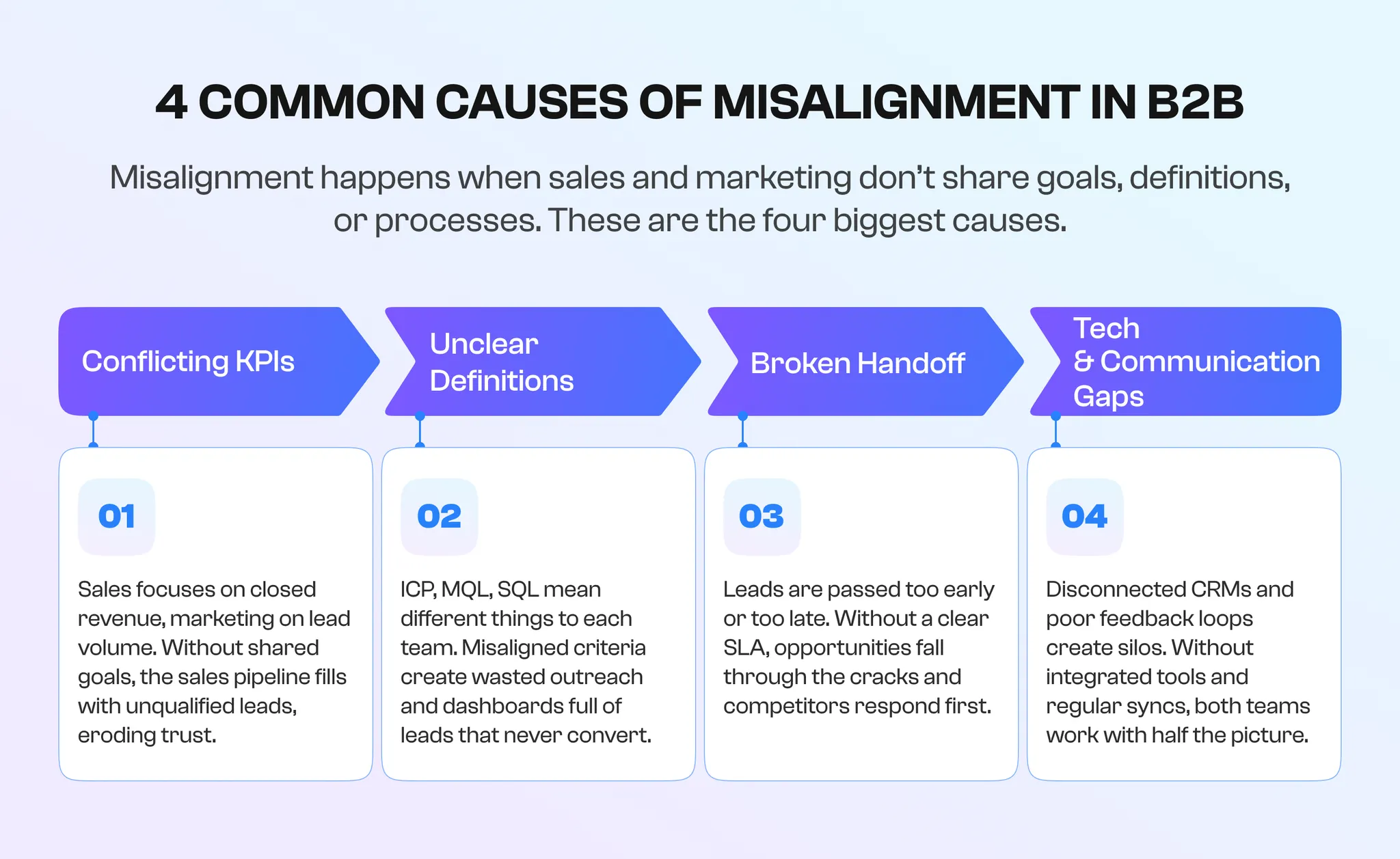
Different KPIs: Marketing Measured by Lead Volume, Sales by Closed Revenue
This is the #1 root cause of tension. Marketing is often tasked with generating “as many leads as possible.” The problem? If lead quality isn’t tied to revenue outcomes, the pipeline fills up with names that never close.
Here’s what happens in practice:
- Marketing spends heavily on paid campaigns that drive ebook downloads.
- Sales looks at the list and says, “None of these people have a budget or intent.”
- The cycle repeats, and trust between the teams erodes.
A fix we apply with clients is shifting both teams toward sales-qualified appointments (SQAs) as a core KPI. Marketing tracks how many prospects meet the qualification criteria; sales measures how many of those prospects convert into a pipeline. One number both care about, no finger-pointing.
Unclear Definitions: ICP, MQL, SQL Not Standardized
Misalignment isn’t always about effort — sometimes it’s about speaking two different languages. If your Ideal Customer Profile isn’t crystal clear, marketing can’t target effectively, and sales can’t prioritize intelligently.
Consider this:
- Marketing says the ICP is “companies in fintech with 50–200 employees.”
- Sales adds, “Only Series A+ companies with an in-house CTO.”
- The SDR team then builds lists that include both, but messaging falls flat because it tries to appeal to everyone.
The same issue happens with lead qualification:
- One marketer refers to someone as an MQL after they download a white paper
- A salesperson won’t consider them an SQL until they request a demo
- Result: thousands of MQLs celebrated in dashboards, zero movement in the pipeline
When both teams know exactly who they’re targeting and when to pass leads forward, B2B sales and marketing alignment finally becomes operational, not theoretical.
Broken Handoff: Leads Passed Too Early/Late Without Process
Even when ICPs and definitions are clear, the lead handoff can derail everything. Without structure, leads fall through the cracks.
Here’s what broken handoff looks like: Marketing sends leads after a webinar registration is completed. Sales calls — the prospect doesn’t even remember signing up. Marketing continues to nurture a prospect who’s already budget-approved. By the time sales gets the lead, the competitor has booked the first meeting.
Book a call with SalesAR today and turn broken handoffs into booked meetings.
SalesAR Insight: 50% of buyers choose the vendor who responds first. If leads aren’t routed to sales within minutes or hours, the odds of winning drop dramatically.
And yet, in many companies, there’s no SLA in place. Sales follow-up “when they can.” Marketing “hopes” leads are being worked on. At SalesAR, we insist that clients create a handoff SLA that covers:
- Lead scoring rules — what makes someone “ready” for sales
- Response times — sales commits to follow up in under 24 hours (ideally under 1 hour)
- Feedback loop — sales reports back weekly on lead quality
Without this, alignment breaks down, regardless of how strong the ICP or KPIs are.
Disconnected CRMs and Marketing Automation Tools
Even if both teams agree on KPIs and ICPs, tech stacks often stand in the way. Marketing runs campaigns in HubSpot or Marketo. Sales lives in Salesforce or Pipedrive. If those systems don’t talk to each other, data gets lost in translation.
The consequences:
- Marketing can’t see which leads turned into opportunities, so they keep doubling down on low-performing channels.
- Sales doesn’t get the full engagement history (email clicks, webinar attendance, website visits) and ends up calling prospects blind.
- Reports to leadership are incomplete, forcing “he said, she said” arguments instead of decisions.
Many B2B companies utilize more than five disconnected sales and marketing alignment solutions, resulting in siloed data and inefficiency. The result is siloed data, duplicated records, and a broken customer journey. When CRM and marketing automation aren’t integrated, alignment is almost impossible. Instead of one view of the buyer, you have two half-truths that never add up.
Lack of Communication: Few Syncs, No Feedback Loops
Misalignment also thrives in silence. Sales has insights about objections, buying cycles, and competitor mentions. Marketing has data on engagement, messaging performance, and campaign ROI. However, if those insights aren’t shared, both teams continue working with only half the picture.
The reality:
- Weekly syncs often get canceled “because everyone is busy.”
- Feedback loops are ad hoc — sales complains about “bad leads” but doesn’t explain why, and marketing doesn’t share campaign learnings in real time.
- Leadership assumes “the teams will figure it out,” but they rarely do without structure.
SalesAR Insight: Only 17% of marketing and sales leaders consider their teams to be tightly aligned. That’s not because people don’t want to work together. It’s because the structure for collaboration doesn’t exist.
Without leadership enforcing shared goals, silos are inevitable. Teams need scheduled touchpoints, shared reporting, and a process for closing the loop on what works and what doesn’t.
Core Alignment Strategies for 2025
So how do you fix all this? It’s not about running more meetings or buying another tool. Proper alignment comes from shared goals, shared accountability, and clear systems.
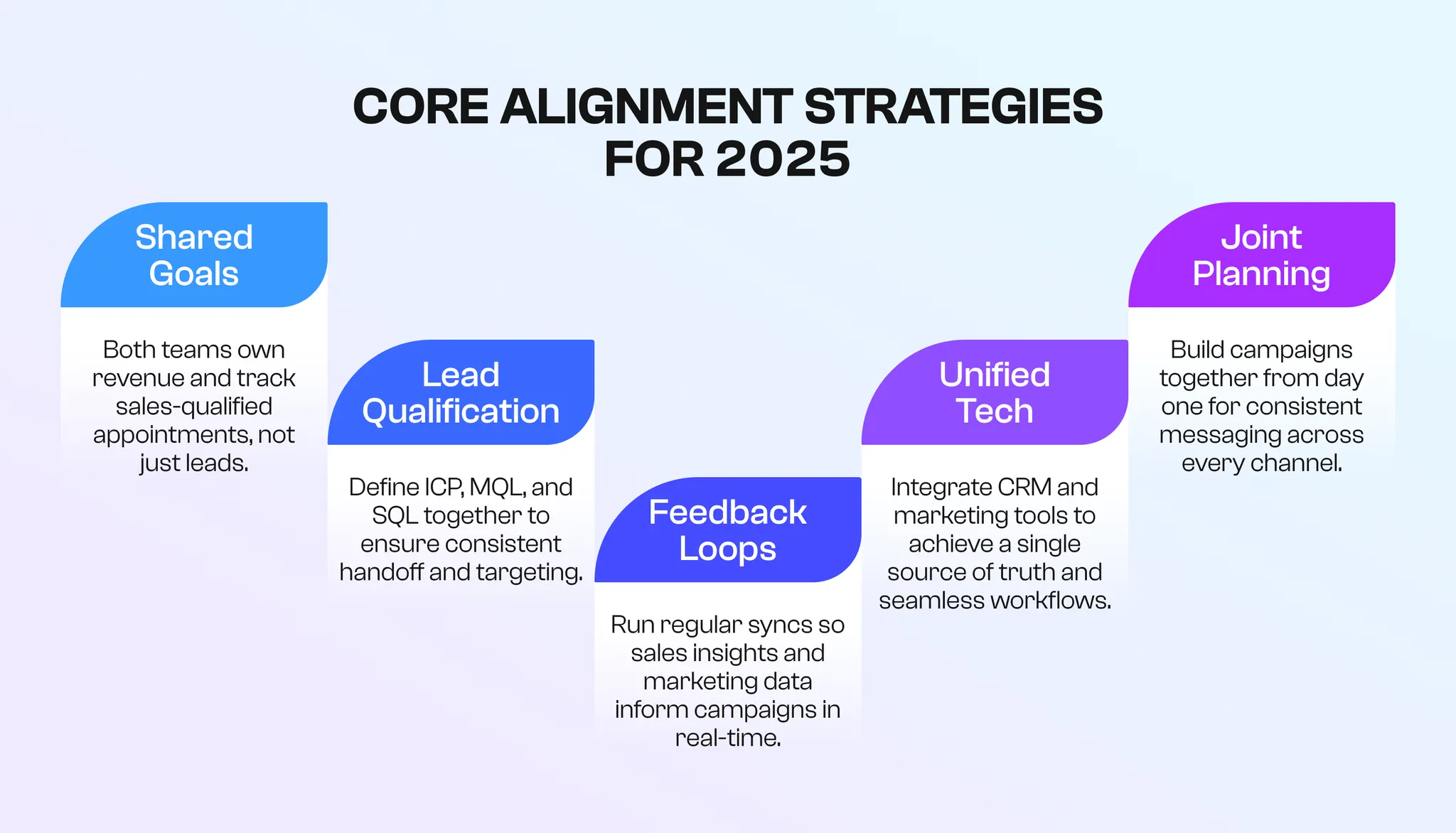
1. Shared Revenue Goals and KPIs
Forget downloads, clicks, or “leads generated.” If those are the targets, marketing will optimize for volume rather than quality. Sales will continue to chase deals, and the gap remains wide.
Here’s the shift that works in practice:
- Agree on a shared revenue target. Instead of separate scorecards, sales and marketing both own a slice of the revenue number. If the company needs $10M in a new pipeline, both are responsible for feeding and closing it.
- Define SQAs as the core metric. At SalesAR, we don’t care how many replies a campaign gets if those replies don’t turn into meetings with decision-makers. We measure marketing effectiveness by the number of sales-qualified appointments it generates. Sales then measures itself on converting those into opportunities.
- Create one reporting dashboard. No more separate spreadsheets for each department. Both teams review the same pipeline data: what has been generated, what’s converting, and what’s closing.
This isn’t about punishing one side or shifting blame. It’s about creating a shared scoreboard where both teams win or lose together. When everyone is chasing the same goal, alignment becomes the default.
2. Standardized Lead Qualification
One of the fastest ways to kill growth is letting sales and marketing define leads differently. If you’ve ever heard “these aren’t real leads” from sales or “sales isn’t following up on my leads” from marketing, you already know the pain. Standardized qualification fixes that.
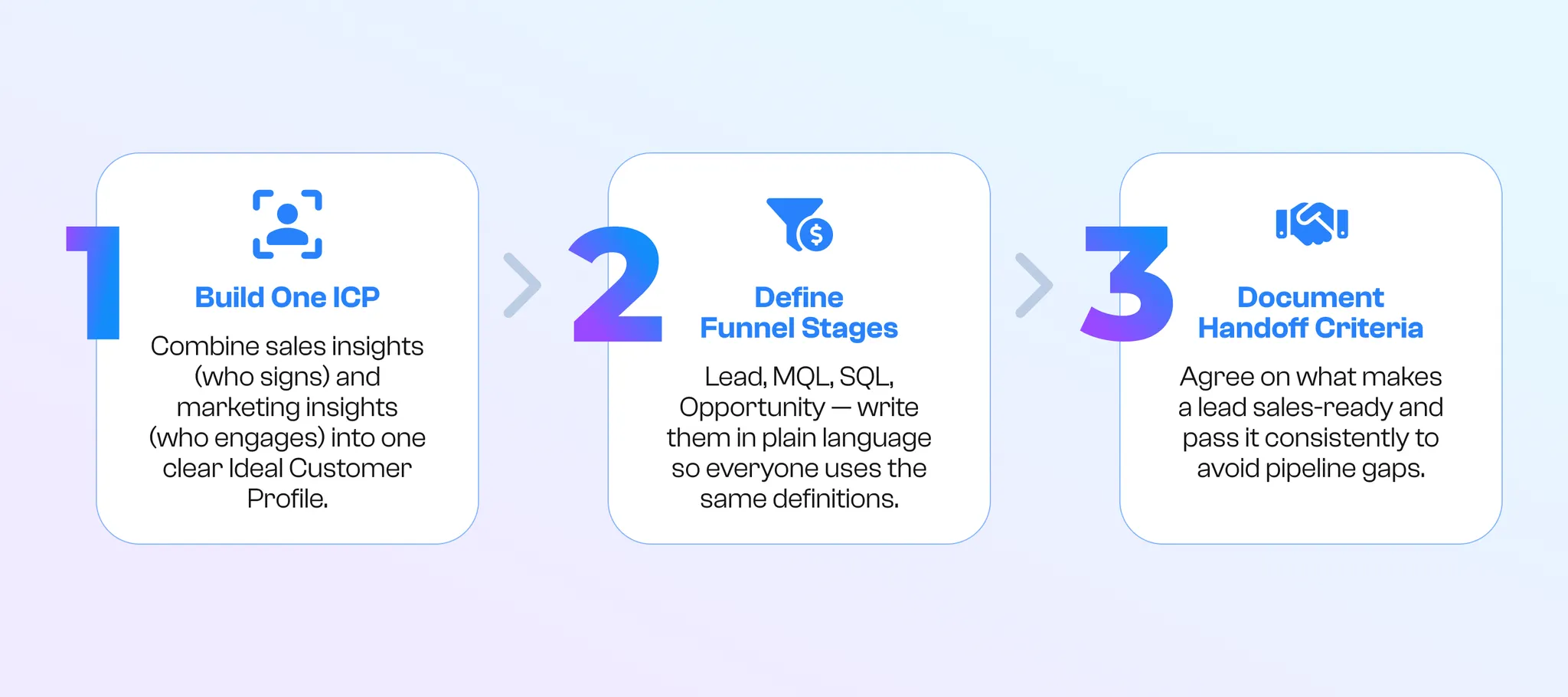
Step 1: Build One ICP
Sales sees patterns in who actually signs contracts. Marketing sees patterns in who engages with campaigns. Both are right — but incomplete. When these insights are combined, the ICP becomes sharper. For example, instead of “mid-market SaaS,” the ICP becomes “SaaS firms with 100–500 employees, Series A+, with a VP of Engineering actively hiring.” That specificity changes targeting and messaging immediately.
Step 2: Define Funnel Stages in Plain Language
- Lead: Fits ICP on paper (title, industry, company size)
- MQL: Shows meaningful engagement (downloads, clicks, replies)
- SQL: Sales has confirmed interest, budget, or timeline
- Opportunity: Qualified SQL tied to an open deal in CRM
Every stage has to be written down. No “we’ll know when we see it.” If a prospect doesn’t tick the boxes, they don’t move forward.
Step 3: Document the Handoff Criteria
This is where deals either flow smoothly or stall. A prospect isn’t sales-ready just because they opened an email. Maybe they’ve engaged twice in a month, fit the ICP, and requested a case study — then they move to sales. That process must be consistent; otherwise, the pipeline turns into a guessing game.
At SalesAR, we treat the qualification matrix as the contract between marketing and sales, making expectations clear before campaigns launch. We always co-create a qualification matrix before campaigns launch. This way, when a lead is passed, both sides know exactly why it’s moving forward and what should happen next.
3. Continuous Feedback Loops
Even with a shared ICP and clear qualification rules, things fall apart if sales and marketing strategy alignment is missing and teams operate in silence. Buyers change quickly — objections shift, new competitors emerge, and budgets fluctuate. If those insights stay locked in sales calls and never reach marketing, campaigns get stale and pipelines slow down.
How to build the loop:
- Run weekly or biweekly syncs. Short, structured check-ins where marketing shares what’s performing in campaigns, and sales shares what they’re hearing on calls. Keep it under 30 minutes, but maintain consistency.
- Use conversations as input. SDR and AE call recordings are gold. They show the exact language prospects use, the objections that matter, and the tone that gets them engaged. Marketing can then refine messaging, landing pages, and outreach templates with that raw material.
- Close the loop on every campaign. If a paid channel delivers leads that never convert, sales needs to say it immediately. If sales keep running into the same objection, marketing should create content that preemptively addresses it.
SalesAR Insight: The best campaign adjustments come directly from the sales floor — conversations reveal what data can’t. A CRM field might tell you a lead’s company size. A call recording will tell you why they’re under pressure to make a decision this quarter. That’s the insight that sharpens campaigns and accelerates deals.
4. Unified Tech and Data
It’s not enough to “have a CRM” or “use a marketing platform.” Most B2B companies already do — but the problem is how they use them. Disconnected tools, duplicate records, missing data fields, and inconsistent tracking create confusion that kills deals.
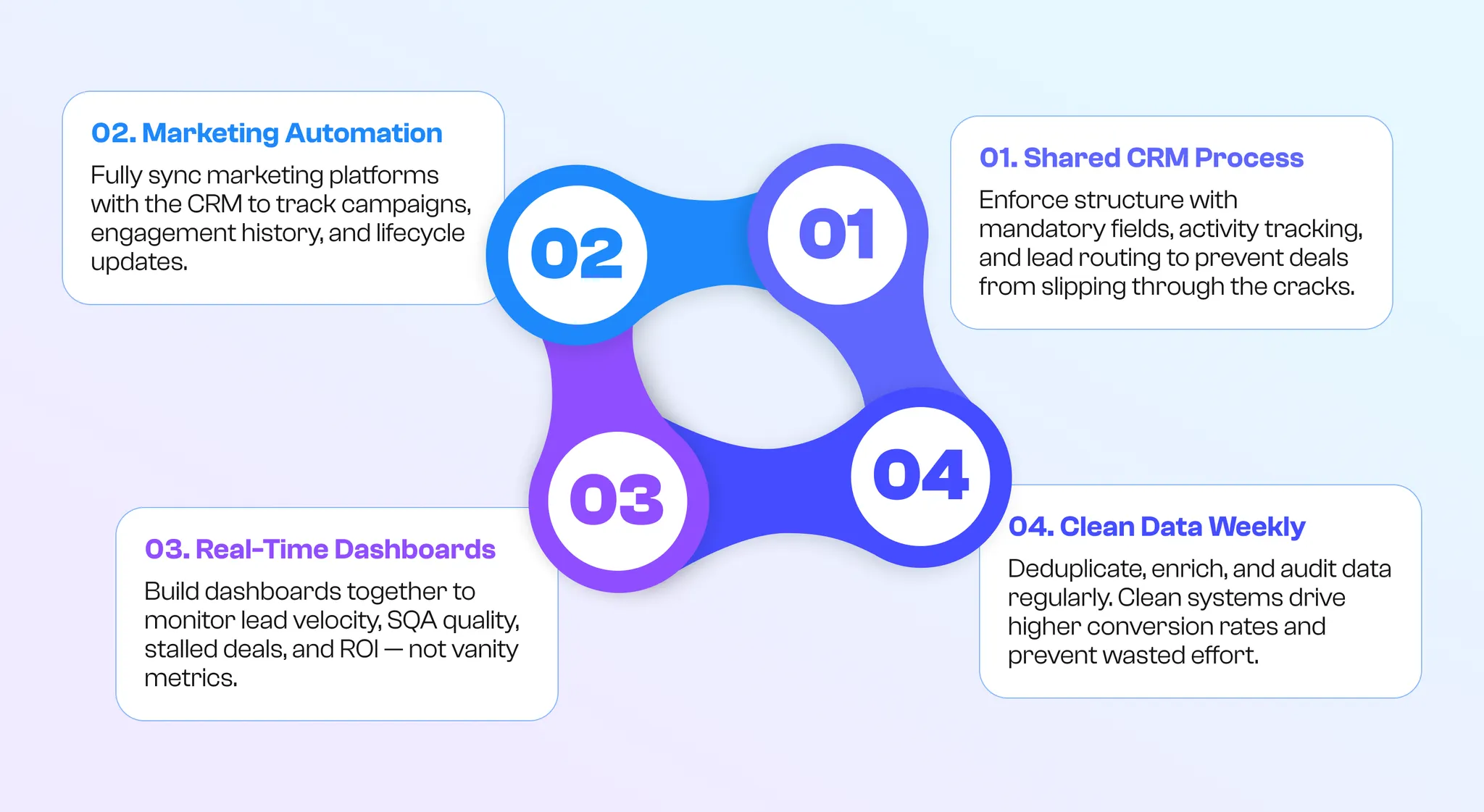
Shared CRM With Enforced Process
Let’s start with the CRM. In practice, many CRMs turn into a graveyard of outdated leads and incomplete notes. That’s not a software issue. It’s a process issue.
Fix it by enforcing structure:
- Mandatory fields: Before a lead is transferred from marketing to sales, specific fields must be completed (industry, job title, last touchpoint, and source).
- Activity tracking rules: Every sales call, email, and meeting is logged — no exceptions. Utilize automation where possible (e.g., auto-log calls, sync calendars).
- Lead routing logic: Set up lead routing that matches ICP segments with the right sales reps or SDRs. No more “who owns this lead?”
We’ve worked with companies where leads sat untouched for days simply because they weren’t assigned to anyone. That’s a CRM flow problem.
Marketing Automation Must Feed the CRM
Marketing can’t afford to fly blind after generating leads — they need to know what happens next. That requires full integration between the marketing automation platform (like HubSpot, Marketo, or Customer.io) and the CRM.
What to sync:
- Lead source and campaign
- Engagement history (emails opened, links clicked, forms filled)
- Lead score based on behavior and fit
- Lifecycle stage updates (e.g., MQL → SQL)
When marketing has visibility into which campaigns convert (not just get clicks), they stop optimizing for surface metrics and start building a real pipeline.
Real-Time Dashboards
A dashboard isn’t helpful unless it drives action. Many teams create reports that appear visually appealing but fail to address the core questions.
Here’s what a useful dashboard shows:
- Lead velocity: How many leads are being generated, accepted, and moved through the funnel.
- SQA volume and quality: Are marketing efforts generating the right meetings? Are those turning into opportunities?
- Stalled deals: Which leads are stuck, and at what stage? Who owns them?
- Channel ROI: Which channels generate SQLs and closed revenue?
SalesAR Insight: Build dashboards together. Sales, marketing, and ops should all have a say in what gets tracked. This avoids the “vanity metric” trap and turns reports into collaborative tools.
Clean the Data Weekly
Even with good technology, insufficient data can still kill deals. Duplicates, outdated contacts, missing fields, and inconsistent tagging silently sabotage your outreach.
Set up hygiene habits:
- Weekly data cleanup rules (deduping, merging, field standardization)
- Lead enrichment from verified tools (e.g., Clearbit, ZoomInfo, Apollo)
- Automated alerts when key fields are missing (e.g., account size, decision-maker title)
- Quarterly audits of lead quality vs. conversion
At SalesAR, we’ve seen clients increase their conversion rate from 2% to 12% simply by cleaning their CRM and refining the way leads are tagged and scored.
When systems are unified, data is clean, and insights are visible in real time, alignment becomes automatic. Sales and marketing consulting for B2B often focuses on eliminating the guessing game and integrating teams into a unified system.
Talk to SalesAR and unify your go-to-market strategy into one powerful engine.
5. Joint Campaign Planning
Sales and marketing might share revenue goals, funnel definitions, and tools — but if they’re running separate campaigns, it still doesn’t work. In 2025, every outbound or inbound motion should be built together from the start. Not handed off. Not “informed by.” Built together.
Here’s what joint campaign planning looks like in practice:
Sales Inputs Shape the Content Roadmap
Marketing doesn’t create campaigns in a vacuum. Instead, they bring in sales early — especially SDRs and AEs who are on the front lines.
Sales shares:
- Common objections heard in calls
- Language prospects used to describe pain
- Competitor narratives that keep showing up
- Topics that spark actual buying interest
This input shapes:
- Email copy and nurture sequences
- Ad headlines and targeting
- Landing page messaging
- Webinar titles and speaking points
When sales feel like the messaging reflects what actually works, they’re far more likely to use the materials in their outreach.
Marketing Supports Execution
Joint planning also means marketing doesn’t just launch campaigns and walk away. They stay close to execution — helping reps with LinkedIn outreach, building target lists for ABM, refining ad audiences, and creating collateral that shortens the sales cycle.
For example:
- Supporting SDRs with personalized email copy tied to campaign themes
- Running retargeting ads for prospects already engaged in the sales cycle
- Building battlecards and objection-handling slides based on active campaigns
- Aligning content offers with specific pipeline stages (top-of-funnel vs. bottom-of-funnel)
This is where most companies miss. They run outreach and PPC separately. They push events without syncing them to ABM. They write content that the SDRs never send.
Consistency Across Every Channel
If a prospect sees one value prop in your ads, another in your LinkedIn outreach, and something else on your landing page — they won’t convert.
In joint planning, teams align on:
- Messaging hierarchy (what’s the one core idea per campaign?)
- Channel-specific adaptations (how the idea changes for LinkedIn vs. email vs. events)
- Timing (when sales follow-up happens relative to ad launches or content drops)
This ensures a seamless experience, whether someone comes in via an ad click, a cold email, or a conference booth.
Joint campaign planning makes marketing and sales feel like owners, not recipients. It makes marketing more accountable for results. And it ensures that every campaign has a single, strong message with whole team buy-in.
Advanced Alignment Tactics Driving B2B Growth in 2025
Once the foundations are in place, the next step is to scale alignment in ways that directly drive revenue. In 2025, top-performing B2B teams are co-owning highly strategic initiatives, including ABM, AI-based prioritization, and market expansion through outsourced teams.
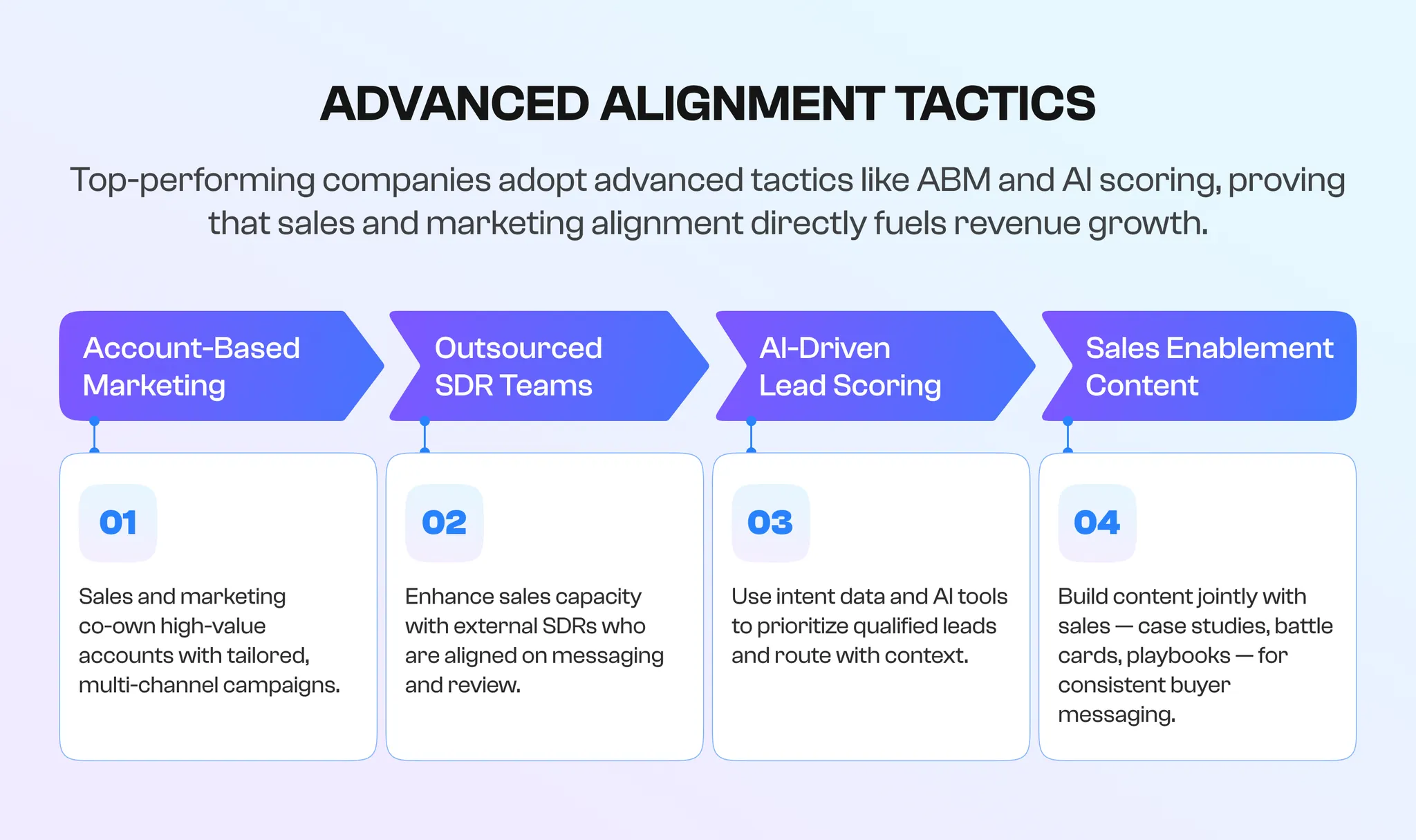
Let’s examine four high-impact tactics that transform alignment into growth.
Account-Based Marketing (ABM)
ABM isn’t new, but it fails when it’s siloed. When sales and marketing truly co-own ABM, it becomes a precision engine for revenue.
How it works when aligned:
- Marketing and sales jointly select a list of high-value target accounts — based on revenue potential, fit, and buying signals.
- Custom outreach campaigns are built around those accounts, with messaging tailored to key stakeholders.
- Ads, cold emails, LinkedIn touches, and content are all coordinated around account activity.
Marketing warms the account. Sales close it. And both share credit, proving the ROI of professional sales and marketing alignment services in ABM campaigns. At SalesAR, we see ABM work best when it’s not a “marketing project,” but a shared motion with clear revenue targets and regular syncs on progress per account.
Outsourced SDR Teams
Fast-growing B2B companies often struggle with outreach bandwidth or with hiring in new regions. Enter outsourced SDR teams: a strategic extension of your in-house sales engine.
Where alignment matters:
- Marketing shares positioning, value props, personas, and messaging assets.
- Outsourced SDRs use these inputs in cold email, cold calls, and LinkedIn outreach.
- Conduct sales reviews to track outcomes, identify objection patterns, and assess meeting quality every week.
It’s a win-win when managed correctly. Marketing doesn’t have to slow down outreach for new campaigns, and sales get a steady stream of sales-qualified appointments.
AI-Driven Lead Scoring: Prioritizing by Intent Signals
Alignment is lost when sales are overwhelmed with unqualified leads. AI-powered scoring solves this if both teams agree on what signals matter.
How this looks in practice:
- Sales and marketing define what “high intent” looks like — pages visited, frequency, job titles, and previous engagement.
- AI tools (like 6sense, MadKudu, or custom scoring logic in CRMs) assign scores based on fit and behavior.
- Leads that pass the threshold are automatically routed to SDRs with full context.
SalesAR Insight: When done correctly, this eliminates 80% of the guesswork from lead handoffs. Sales spends time where the intent is real. Marketing can be optimized to target the behaviors that drive results.
Sales Enablement Content
Too often, sales enablement content is created after the fact. Real alignment means building this content with the sales team, not for them.
What aligned content looks like:
- Case studies written with input from AEs who closed the deal, focusing on real objections and impact.
- Battle cards co-built by marketing and sales to address competitors’ sales strategies that repeatedly encounter issues.
- Email sequences and templates refined using SDR feedback on what’s landing — and what’s not.
- Playbooks for vertical-specific pitches, written jointly to standardize what works.
The result? Sales teams actually use the materials, and marketing gets real-time feedback to improve them. Everyone speaks the same language, and the buyer hears a consistent, compelling story across every touchpoint.
Together, these tactics extend it into areas where revenue is made: targeting, outreach, prioritization, and closing.
The Business Impact of Sales and Marketing Alignment
When marketing and sales are aligned, companies close more deals, shorten sales cycles, and increase customer lifetime value. Alignment affects every major revenue lever. Here’s what changes when teams move from disjointed to coordinated:

Higher Conversion Rates
Misaligned teams hand off cold or poorly timed leads. Aligned teams hand off sales-ready buyers. The result is a smoother buyer journey with fewer drop-offs.
How this looks in practice:
- Sales enters conversations with full context: what content was consumed, what problems the lead cares about, and who else is in the buying committee.
- Leads are warmed through campaigns that match their stage in the journey, not generic nurture drips.
- Messaging remains consistent from the first click to the final proposal.
When every touchpoint is aligned — from cold email to discovery call to closing deck — conversion rates rise across the board.
Shorter Sales Cycles
Without alignment, sales reps waste time requalifying leads, restating value props, and addressing gaps marketing should have covered. Aligned teams move faster.
- Prospects already know what the product does and why it’s relevant.
- Objections are handled earlier through strategic content and retargeting.
- Buyers feel understood before they even meet sales.
This speed matters. A shorter sales cycle means more deals per quarter, faster revenue recognition, and fewer deals going dark.
Improved Forecasting and Budget Allocation
When sales and marketing speak the same data language, leadership sees exactly what’s working. This makes growth predictable instead of reactive.
- Marketing can double down on channels that drive real SQLs.
- Sales can forecast the sales pipeline based on lead quality.
- Leadership can tie revenue back to campaigns.
Aligned teams have better attribution models, more accurate forecasts, and fewer budget surprises.
Stronger Win Rates in Competitive Deals
In crowded markets, the team that delivers the most relevant, timely, and consistent buyer experience wins. Alignment is how that experience gets built.
- Content speaks directly to pain points uncovered by sales
- Campaigns are adapted in real time based on sales feedback
- Prospects receive coordinated messages across email, ads, events, and LinkedIn
Compounding Growth
The better sales and marketing work together, the more insight they generate. That insight improves targeting, messaging, and strategy for the next cycle.
- More deals → more data → better ICP clarity
- More feedback → sharper campaigns → higher engagement
- More transparency → faster decision-making → scalable growth
Conclusion
Alignment isn’t about being on good terms. It’s about building a system where sales and marketing work together to drive revenue, with shared goals, unified tools, and clear communication.
If your teams still operate in silos, if leads stall after handoff, or if no one agrees on what “qualified” means, it’s time to fix the foundation. Growth in 2025 requires precision — and that only comes when sales and marketing alignment functions as a single, unified engine.
Start with a simple audit:
- Are your KPIs tied to revenue or activity?
- Do you have a shared ICP, funnel, and handoff process in place?
- Are systems integrated, and is data reliable?
- Do sales and marketing teams provide each other with regular feedback?
If the answer to any of these is “not really”, you’re leaving revenue on the table.
We help B2B companies build fully integrated outbound systems — from shared KPIs and SDR support to ABM, lead scoring, and campaign execution. Let’s create a pipeline both teams believe in and watch growth follow.
Align your sales and marketing with SalesAR and start building the predictable pipeline your team deserves.


